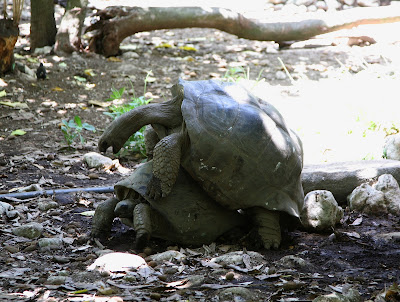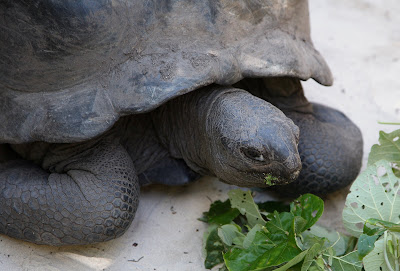Reference book is again The Birds of the Seychelles (Later BoS).
COUSIN:
Cousin is situated 2 km west of the northwest tip of Praslin. International Council for Bird Preservation (now BirdLife International) purchased the island in 1968. Birdlife International managed the island up to 1998 when the task was passed to BirdLife Seychelles. The island has been a nature reserve since 1975. The purchase of Cousin propably saved Seychelles Warbler from extinction, this being its last surviving home at this time (Bos).

Turnstone passed our ferry on the way to Cousin.

Turnstone taking off.

Lesser Noddy was in sight just after coming ashore

as was Fairy Tern

and White-tailed Tropicbird.

Extra hands or sandals are difficult to crop from the photograph. Anyway, the dimensions of the tortoise are easier to proportion if you have a point of comparison.

Seychelles Magpie-robin was once common throughout the granitics until its extinction on all islands except Frégate. It is now making a comeback under a BirdLife programme involving re-introduction to several islands (BoS).

Magpie-robin is strongly territorial (BoS) and it seemed to be very tame too. Newton noted it ' ... is the boldest and most familiar bird I ever saw. It will approach within a few feet and when sitting on the branch of a tree will allow itself to be knocked down with a stick as one when I was there, (on Praslin) by a man whom we brought with us' (BoS).

Magpie-robin is endemic to granitic islands and resident Frégate, Cousin, Cousine and Aride with a total population in 2000 of c90 birds (BoS).
I lost my group when focusing on the Magpie-robin. I took a wrong path and heard loud roaring from farther off - no one has mentioned anything about lions.

How can anyone descend to this sort of photographing? It is only a matter of time when the tortoises' solicitor will pay a visit. The visit won't be a social one, but to deliver a written summons. It is undoubtedly aggravating that this is not the first time I was caught in the act of commiting filthy photographing.

Fairy Tern was at close range.

Fairy Tern's fledgling doesn't turn white until an adult.

Seychelles Fody is endemic to the granitic islands occuring on Cousin, Cousine and Frégate and is introduced on D'Arros (BoS).

Seychelles Warbler is also endemic, breeding in Aride (c2000 birds), Cousin (c350 birds) and Cousine (c150 birds) (BoS).
BoS doesn't consider Couriese as an important bird watching site, but something can be found anyway.

Moorhens were even tamer here than in Cousin.

Madagascar Turtle Dove is common throughout granitics.

Tortoises attract visitors also to Couriese.

Tortoises liked to get fed on leaves.
LA DIGUE:
La Digue is situated 3 km east of the southeast coast of Praslin.

Beaches are nice

as are the granite rocks.

Ox carts are a common way to take quests to their hotel.

A flock of tortoises.
However, la Digue is best renowned as the home of Seychelles Paradise Flycatcher.






Ei kommentteja:
Lähetä kommentti